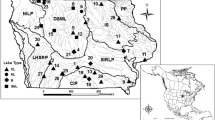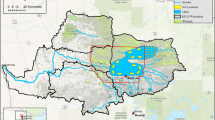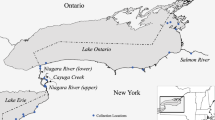Abstract
Fish mercury concentrations have received considerable attention due to human health implications. Fish mercury concentrations are variable within and among systems due to a suite of biotic and abiotic influences that vary among regions and are difficult to predict. Understanding factors associated with variability in fish mercury concentrations would help guide consumption advisories. Mercury concentrations in channel catfish (Ictalurus punctatus, n = 205), flathead catfish (Pylodictis olivaris, n = 123), northern pike (Esox lucius, n = 60), smallmouth bass (Micropterus dolomieu, n = 176), and walleye (Sander vitreus, n = 176) were assessed in ten Iowa rivers and relationships with land use, water chemistry, and fish characteristics were explored. Mercury concentrations were generally low (mean among all species = 0.17 mg/kg, n = 740) but higher in flathead catfish, northern pike, smallmouth bass, and walleye than channel catfish and were positively related to fish length, age, trophic position, and δ13C signatures. Phosphorus, sulfate, and percent open water and grassland were negatively related to fish mercury concentrations, whereas water hardness, nitrogen-ammonia, Human Threat Index, and percent wetland and forest were positively related to fish mercury concentrations. Fish collected from the Paleozoic Plateau ecoregion in northeast Iowa had higher mercury concentrations than other ecoregions in Iowa. Combined, these factors explained 70% of the variation in fish mercury concentrations. This study provides a comprehensive analysis of abiotic and biotic factors influencing fish mercury concentrations in lotic ecosystems at the individual and system scale that will help guide fish consumption advisories.





Similar content being viewed by others
References
Annis GM, Sowa SP, Diamond DD, Combes MD, Doisy KE, Garringer AJ, Hanberry P (2010) Developing synoptic human threat indices for assessing the ecological integrity of freshwater ecosystems in EPA Region 7. Final report. Environmental Protection Agency, 192pp
Atwell L, Hobson KA, Welch HE (1998) Biomagnification and bioaccumulation of mercury in arctic marine food webs: insights from stable nitrogen isotope analysis. Can J Fish Aquat Sci 55:1114–1121
Benoit JM, Gilmour C, Heyes A, Mason RP, Miller C (2003) Geochemical and biological controls over methylmercury production and degradation in aquatic ecosystems. In: Chai Y, Braids OC. Biogeochemistry of Environmentally Important Trace Elements. Washington, DC: American Chemical Society. ACS Symposium Series no. 835, pp 262–297
Beutel MW (2016) The other internal loading—a look at nitrogen and mercury. N Am Lake Manage Soc. Lakeline 36: 13–16
Burnham KP, Anderson DR (1998) Model selection and inference: a practical information-theoretic approach. Springer-Verlag, New York
Cabana G, Rasmussen JB (1994) Modeling food chain structure and contaminant bioaccumulation using stable nitrogen isotopes. Let Nat 372:255–257
Cabana G, Rasmussen JB (1996) Comparison of aquatic food chains using nitrogen isotopes. Proc Nat Acad Sci 93:844–847
Chen CY, Folt CL (2005) High plankton densities reduce mercury biomagnification. Environ Sci Tech 39:115–121
Driscoll CT, Han YJ, Chen CY, Evers DC, Lambert KF, Holsen TM, Kamman NC, Munson RK (2007) Mercury contamination in forest and freshwater ecosystems in the Northeastern United States. BioSci 57:17–28
Ekstrom EB, Morel FMM, Benoit JM (2003) Mercurymethylation independent of the acetyl-aoenzyme: a pathway in sulfate reducing bacteria. Appl Environ Microbiol 69:5414–5422
Garcia SL, Salka I, Grossart HP, Warnecke F (2013) Depth-discrete profiles of bacterial communities reveal pronounced spatio-temporal dynamics related to lake stratification. Environ Biol Rep 4:549–555
Gilmour CC, Henry EA, Mitchell R (1992) Sulfate stimulation of mercury methylation in freshwater sediments. Environ Sci Technol 26:2281–2287
Glover JB, Domino ME, Altman KC, Dillman JW, Castleberry WS, Eidson JP, Mattocks M (2010) Mercury in South Carolina fishes. Usa Ecotox 19:781–795
Hayer CA, Chipps SR, Stone JJ (2010) Influence of physiochemical and watershed characteristics on mercury concentration in walleye, Sander vitreus. M Bul Environ Contam Tox 86:163–167
Houck A, Cech Jr. JJ (2004) Effects of dietary methylmercury on juvenile Sacramento blackfish bioenergetics. Aquat Tox 69:107–123
Iowa Department of Natural Resources (IDNR), Ambient Stream Monitoring Program (2015) http://www.iowadnr.gov/Environmental-Protection/Water-Quality/Water-Monitoring/Streams
Kamman NC, Burgess NM, Driscoll CT, Simonin HA, Goodale W, Linehan J, Estabrook R, Hutcheson M, Major A, Scheuhammer AM, Scruton DA (2005) Mercury in freshwater fish of the Northeast North America—a geographic perspective based of fish tissue monitoring databases. Ecotox 14:163–180
Larsson P, Collvin L, Lennart O, Meyer G (1992) Lake productivity and water chemistry as governors of the uptake of persistent pollutants in fish. Environ Sci Tech 26:346–351
Matilainen T, Verta M, Korhonen H, Uusi-Rauva A, Niemi M (2001) Behavior of mercury in soil profiles: impact of increased precipitation, acidity, and fertilization on mercury methylation. Water, Air, Soil Poll 125:105–119
McCorvie MR, Lant CL (1993) Drainage district formation and the loss of Midwestern wetlands, 1850-1930. Agric Hist 67:13–39
Mills N, Cashatt D, Weber MJ, Pierce CL (2018) A case study and a meta-analysis of seasonal variation in fish mercury concentrations. Ecotoxicology. https://rdcu.be/NZ2c
Murata K, Sakamoto M, Nakai K, Dakeishi M, Iwata T, Liu XJ, Satoh H (2006) Subclinical effects of prenatal methylmercury exposure on cardiac autonomic function in Japanese children. Intern Arch Occup Environ Health J 79:379–386
Olsson M (1976) Mercury level as a function of size and age in northern pike, one and five years after the mercury ban in Sweden. Ambio 5:73–76
Overman NC, Parrish DL (2001) Stable isotope composition of walleye:15N accumulation with age and area-specific difference in δ13C. Can J Fish Aquat Sci 58:1253–1260
Phillips GR, Gregory RW (1979) Assimilation efficiency of dietary methylmercury by northern pike (Esox lucius). J Fish Resour Board Can 36:1516–1519
Phillips GR, Lenhart TE, Gregory RW (1980) Relation between trophic position and mercury accumulation among fishes from the Tongue River Reservoir, Montana. Environ Res 22:73–80
Pickhardt PC, Folt CL, Chen CY, Klaue B, Blum JD (2002) Algal blooms reduce the uptake of toxic methylmercury in freshwater food webs. Ecology 99:4419–4423
Pickhardt PC, Stepanova M, Fisher NS (2006) Contrasting uptake routes and tissue distributions of inorganic and methylmercury in mosquitofish (Gambusia affinis) and redear sunfish (Lepomis microlophus). Environ Tox Chem 25:2132–2142
Post M (2002) Using stable isotopes to estimate trophic position: models, methods, and assumptions. Ecology 83:703–718
Power M, Klein GM, Guiguer KRRA, Kwan MKH (2002) Mercury accumulation in the fish community of a sub-Arctic lake in relation to trophic position and carbon sources. J Appl Ecol 39(819):830
Ribaudo MO (1989) Water-quality benefits from the Conservation Reserve Program. United States, Economic Research Service, Washington, D.C.
Rolfhus KR, Hall BD, Monson BA, Paterson MJ, Jermiason JD (2011) Assessment of mercury bioaccumulation within the pelagic food web of lakes in the western Great Lakes region. Ecotox 20:1520–1529
Rypel AL, Arrington DA, Findlay RH (2008) Mercury in southeastern U.S. riverine fish populations linked to water body type. Environ Sci Tech 42:5118–5124
Rypel AL (2010) Mercury concentrations in lentic fish populations related to ecosystem and watershed characteristics. Ambio 39:14–19
Sackett DA, Aday DD, Rice JA, Cope WG (2009) A statewide assessment of mercury dynamics in North Carolina water bodies and fish. Trans Am Fish Soc 138:1328–1341
Scheuhammer AM, Meyer MW, Sandheinrich MB, Murray MW (2007) Effects of environmental methylmercury on the health of wild birds, mammals, and fish. Ambio 36:12–18
Selch TM, Hoagstrom CW, Weimer EJ, Duehr JP, Chipps SR (2007) Influence of fluctuating water levels on mercury concentrations in adult walleye. Bull Environ Contam Toxicol 79:36–40
Simonin HA, Loukmas JJ, Skinner LC, Roy KM (2008) Lake variability: key factors controlling mercury concentrations in New York fish. Environ Poll 154:107–115
Skyllberg U, Qian J, Frech W, Xia K, Bleam WF (2003) Distribution of mercury, methyl mercury and organic sulphur species in soil, soil solution and stream of a boreal forest catchment. Biogechem 64:53–76
Thomas Lumley using Fortran code by Alan Miller (2009) leaps: regression subset selection. R package version 2.9. http://CRAN.R-project.org/package=leaps
Tremain DM, Adams DH (2012) Mercury in groupers and sea basses from the Gulf of Mexico: relationships with size, age, and feeding ecology. Trans Am Fish Soc 141:1274–1286
Tyus HM, Nikirk NJ (1990) Abundance, growth, and diet of channel catfish, Ictalurus punctatus, in the Green and Yampa Rivers, Colorado and Utah. Southwest Nat 35:188–198
[USEPA] United States Environmental Protection Agency (1998) Method 6020A Inductively Coupled Plasma—Mass Spectrometry. https://www.epa.gov/sites/production/files/2015-07/documents/epa-6020a.pdf
[USEPA] United States Environmental Protection Agency (2000) Guidance for Assessing Chemical Contaminant Data for Use in Fish Advisories, Vol 1. Fish Sampling and Analysis, 3rd edn. Office of Science and Technology and Office of Water, Washington, D.C.
[USEPA] United States Environmental Protection Agency (2003) Technical Standard Operating Procedure Non-lethal Fish Tissue Plug Collection. SOP #EH-07, East Helena Site, Montana
Wentz DA, Brigham ME, Chasar LC, Lutz MA, Krabbenhoft DP (2014) Mercury in the Nation’s streams—Levels, trends, and implications: U.S. Geological Survey Circular 1395, 90pp. https://doi.org/10.3133/cir1395.
Wiener JG, Spry DJ (1996) Toxicological significance of mercury in freshwater fish. In: Redmon-Norwood AW Environmental contaminants in wildlife, interpreting tissue concentrations, CRC/Lewis Publishers, Boca Raton, pp 297–339
[USDA] United States Department of Agriculture (2000) Natural Resources Conservation Service. 1997 National Resources Inventory, Washington, DC
Acknowledgements
This project is funded by the Iowa Department of Natural Resources through contract 14CRDFBGSCHO-0002 and Iowa State University as part of an ongoing evaluation of mercury contamination in Iowa fishes. We thank numerous fisheries personnel throughout Iowa that have assisted with fish collection for this project, Dr. Philip Dixon for statistical guidance, and Trevor Selch for constructive comments on an earlier draft. Use of trade, product, or firm names is descriptive only and does not imply endorsement by the United States Government.
Author information
Authors and Affiliations
Corresponding author
Ethics declarations
Conflict of interest
The authors declare that they have no conflict of interest. All applicable international, national, and/or institutional guidelines for the care and use of animals were followed. This study was performed under the Iowa State University Institutional Animal Care and Use Committee (IACUC) protocol permit 4-14-7780-I and animals were collected under state permit SC1037.
Additional information
Publisher’s note: Springer Nature remains neutral with regard to jurisdictional claims in published maps and institutional affiliations.
Rights and permissions
About this article
Cite this article
Mills, N., Weber, M.J., Pierce, C.L. et al. Factors influencing fish mercury concentrations in Iowa rivers. Ecotoxicology 28, 229–241 (2019). https://doi.org/10.1007/s10646-019-02017-1
Accepted:
Published:
Issue Date:
DOI: https://doi.org/10.1007/s10646-019-02017-1




